Ventilation and Pollutant Concentration for the Pedestrian Zone, the Near-Wall Zone, and the Canopy Layer at Urban Intersections
Abstract
1. Introduction
2. Methodology
2.1. Description of the Investigated Cases
2.2. CFD Set-Up
2.3. Evaluation Method and Indices
3. Results
3.1. Ventilation and Pollutant Concentration at Right-Angled Intersections
3.2. Ventilation and Pollutant Concentration at Oblique-Angled Intersections
3.3. Comprehensive Ventilation Analysis
4. Limitations and Prospects
5. Conclusions
- Right-angled intersections have a larger Qtotal but lower β values because of the significant channel effect when the wind direction is parallel to the street canyon. Oblique wind directions led to a lower Qtotal but a higher β value. For T-shaped intersections, a larger cross-sectional area for the outflow appears when the wind direction (φ) = 315°, which helps to increase Qtotal.
- Oblique-angled intersections experience a more significant difference in Qtotal when the wind direction changes. However, β shows higher stability except for the r-shaped asymmetrical intersection or X-shaped intersection for φ = 45°, oblique to the building arrays.
- The vertical air-exchange rates for intersections are considerable when the wind directions are parallel to the street orientation, for example, “+”-shaped intersection when φ = 0°, or when there is no opening in the inflow direction, for example, a Y-shaped intersection when φ = 180°.
- For most cases, the and values for the pedestrian zone and the canopy layer showed similar changes to φ, compared to those for the near-wall zone. There are still cases in which only the or changed substantially; for example, when the Y-shaped intersection experienced a change in the inflow wind direction from 0° to 135°. This reflects the divergence in ventilation and pollutant diffusion at different locations of the intersections.
Author Contributions
Funding
Conflicts of Interest
References
- Lynch, K. The Image of the City; MIT Press: Cambridge, MA, USA, 1960. [Google Scholar]
- Global Designing Cities Initiative; National Association of City Transportation Officials. Global Street Design Guide; Island Press: Washington, DC, USA, 2016. [Google Scholar]
- Lang, J. Urban Design: A Typology of Procedures and Products; Routledge: Oxfordshire, UK, 2006. [Google Scholar]
- Marshall, S. Streets and Patterns; Routledge: Oxfordshire, UK, 2004. [Google Scholar] [CrossRef]
- Guo, X.; Buccolieri, R.; Gao, Z.; Zhang, M.; Lyu, T.; Rui, L.; Shen, J. On the effects of urban-like intersections on ventilation and pollutant dispersion. Build. Simul. 2021. [Google Scholar] [CrossRef]
- Carpentieri, M.; Salizzoni, P.; Robins, A.; Soulhac, L. Evaluation of a neighbourhood scale, street network dispersion model through comparison with wind tunnel data. Environ. Modell. Softw. 2012, 37, 110–124. [Google Scholar] [CrossRef]
- Wang, X.; McNamara, K.F. Effects of street orientation on dispersion at or near urban street intersections. J. Wind Eng. Ind. Aerodyn. 2007, 95, 1526–1540. [Google Scholar] [CrossRef]
- Yassin, M.F.; Kellnerová, R.; Jaňour, Z. Impact of street intersections on air quality in an urban environment. Atmos. Environ. 2008, 42, 4948–4963. [Google Scholar] [CrossRef]
- Carpentieri, M.; Robins, A.G. Tracer Flux Balance at an Urban Canyon Intersection. Bound.-Lay. Meteorol. 2010, 135, 229–242. [Google Scholar] [CrossRef]
- Mirzaei, P.A.; Haghighat, F. Pollution removal effectiveness of the pedestrian ventilation system. J. Wind Eng. Ind. Aerodyn. 2011, 99, 46–58. [Google Scholar] [CrossRef]
- Shen, J.; Gao, Z.; Ding, W.; Yu, Y. An investigation on the effect of street morphology to ambient air quality using six real-world cases. Atmos. Environ. 2017, 164, 85–101. [Google Scholar] [CrossRef]
- He, Y.; Tablada, A.; Wong, N.H. A parametric study of angular road patterns on pedestrian ventilation in high-density urban areas. Build. Environ. 2019, 151, 251–267. [Google Scholar] [CrossRef]
- Herriott, R. The Topological Relations of Corner Buildings at Street Junctions. J. Archit. Urban 2016, 40, 322–334. [Google Scholar] [CrossRef][Green Version]
- Hang, J.; Luo, Z.; Wang, X.; He, L.; Wang, B.; Zhu, W. The influence of street layouts and viaduct settings on daily carbon monoxide exposure and intake fraction in idealized urban canyons. Environ. Pollut. 2017, 220, 72–86. [Google Scholar] [CrossRef]
- Mei, S.; Luo, Z.; Zhao, F.; Wang, H. Street canyon ventilation and airborne pollutant dispersion: 2-D versus 3-D CFD simulations. Sustain. Cities Soc. 2019, 50, 101700. [Google Scholar] [CrossRef]
- Wong, P.P.Y.; Lai, P.; Allen, R.; Cheng, W.; Lee, M.; Tsui, A.; Tang, R.; Thach, T.; Tian, L.; Brauer, M.; et al. Vertical monitoring of traffic-related air pollution (TRAP) in urban street canyons of Hong Kong. Sci. Total Environ. 2019, 670, 696–703. [Google Scholar] [CrossRef]
- Ahmad, K.; Khare, M.; Chaudhry, K.K. Wind tunnel simulation studies on dispersion at urban street canyons and intersections—A review. J. Wind Eng. Ind. Aerodyn. 2005, 93, 697–717. [Google Scholar] [CrossRef]
- Soulhac, L.; Garbero, V.; Salizzoni, P.; Mejean, P.; Perkins, R.J. Flow and dispersion in street intersections. Atmos. Environ. 2009, 43, 2981–2996. [Google Scholar] [CrossRef]
- Dabberdt, W.; Hoydysh, W.; Schorling, M.; Yang, F.; Holynskyj, O. Dispersion modeling at urban intersections. Sci. Total Environ. 1995, 169, 93–102. [Google Scholar] [CrossRef]
- Hoydysh, W.G.; Dabberdt, W.F. Concentration fields at urban intersections: Fluid modeling studies. Atmos. Environ. 1994, 28, 1849–1860. [Google Scholar] [CrossRef]
- Guo, X.; Gao, Z.; Buccolieri, R.; Zhang, M.; Shen, J. Effect of greening on pollutant dispersion and ventilation at urban street intersections. Build. Environ. 2021, 203, 108075. [Google Scholar] [CrossRef]
- Blocken, B. LES over RANS in building simulation for outdoor and indoor applications: A foregone conclusion? Build. Simul. 2018, 11, 821–870. [Google Scholar] [CrossRef]
- Buccolieri, R.; Sandberg, M.; Di Sabatino, S. City breathability and its link to pollutant concentration distribution within urban-like geometries. Atmos. Environ. 2010, 44, 1894–1903. [Google Scholar] [CrossRef]
- Hang, J.; Li, Y.; Sandberg, M.; Buccolieri, R.; Di Sabatino, S. The influence of building height variability on pollutant dispersion and pedestrian ventilation in idealized high-rise urban areas. Build. Environ. 2012, 56, 346–360. [Google Scholar] [CrossRef]
- Franke, J.; Hellsten, A.; Schluenzen, K.H.; Carissimo, B. The COST 732 Best Practice Guideline for CFD simulation of flows in the urban environment: A summary. Int. J. Environ. Pollut. 2011, 44, 419–427. [Google Scholar] [CrossRef]
- Tominaga, Y.; Mochida, A.; Yoshie, R.; Kataoka, H.; Nozu, T.; Yoshikawa, M.; Shirasawa, T. AIJ guidelines for practical applications of CFD to pedestrian wind environment around buildings. J. Wind Eng. Ind. Aerodyn. 2008, 96, 1749–1761. [Google Scholar] [CrossRef]
- Cao, J.; Zhu, J.; Zhang, Q.; Wang, K.; Yang, J.; Wang, Q. Modeling urban intersection form: Measurements, patterns, and distributions. Front. Archit. Res. 2021, 10, 33–49. [Google Scholar] [CrossRef]
- Zhang, M.; Gao, Z. Effect of urban form on microclimate and energy loads: Case study of generic residential district prototypes in Nanjing, China. Sustain. Cities Soc. 2021, 70, 102930. [Google Scholar] [CrossRef]
- Yang, X.; Zhao, L.; Bruse, M.; Meng, Q. An integrated simulation method for building energy performance assessment in urban environments. Energ. Build. 2012, 54, 243–251. [Google Scholar] [CrossRef]
- U. S. Environmental Protection Agency. Probe and Monitoring Path Siting Criteria for Ambient Air Quality Monitoring. 40 CFR Part 58, Appendix E. Available online: https://www.ecfr.gov/current/title-40/chapter-I/subchapter-C/part-58#Appendix-A-to-Part-58 (accessed on 10 August 2021).
- Hong, B.; Lin, B.; Qin, H. Numerical investigation on the coupled effects of building-tree arrangements on fine particulate matter (PM2.5) dispersion in housing blocks. Sustain. Cities Soc. 2017, 34, 358–370. [Google Scholar] [CrossRef]
- Ji, W.; Zhao, B. Numerical study of the effects of trees on outdoor particle concentration distributions. Build. Simul. 2014, 7, 417–427. [Google Scholar] [CrossRef]
- Van Hooff, T.; Blocken, B. On the effect of wind direction and urban surroundings on natural ventilation of a large semi-enclosed stadium. Comput. Fluids 2010, 39, 1146–1155. [Google Scholar] [CrossRef]
- Sun, D.J.; Wu, S.; Shen, S.; Xu, T. Simulation and assessment of traffic pollutant dispersion at an urban signalized intersection using multiple platforms. Atmos. Pollut. Res. 2021, 12, 101087. [Google Scholar] [CrossRef]
- Adeniran, J.A.; Yusuf, R.O.; Olajire, A.A. Exposure to coarse and fine particulate matter at and around major intra-urban traffic intersections of Ilorin metropolis, Nigeria. Atmos. Environ. 2017, 166, 383–392. [Google Scholar] [CrossRef]
- Tsalicoglou, C.; Allegrini, J.; Carmeliet, J. Non-isothermal flow between heated building models. J. Wind Eng. Ind. Aerodyn. 2020, 204, 104248. [Google Scholar] [CrossRef]
- Shi, T.; Ming, T.; Wu, Y.; Peng, C.; Fang, Y.; de Richter, R. The effect of exhaust emissions from a group of moving vehicles on pollutant dispersion in the street canyons. Build. Environ. 2020, 181, 107120. [Google Scholar] [CrossRef]
- ASHRAE. American society of heating, refrigerating and air-conditioning engineers. In ASHRAE Handbook Fundamentals; ASHRAE Inc.: Atlanta, GA, USA, 2009. [Google Scholar]
- Wang, L.L.; Dols, W.S.; Chen, Q. Using CFD Capabilities of CONTAM 3.0 for Simulating Airflow and Contaminant Transport in and around Buildings. HVAC R Res. 2010, 16, 749–763. [Google Scholar] [CrossRef]
- Zhong, X.; Zhang, Z.; Wu, W.; Ridley, I. Comprehensive evaluation of energy and indoor-PM2.5-exposure performance of residential window and roller blind control strategies. Energ. Build. 2020, 223, 110206. [Google Scholar] [CrossRef]
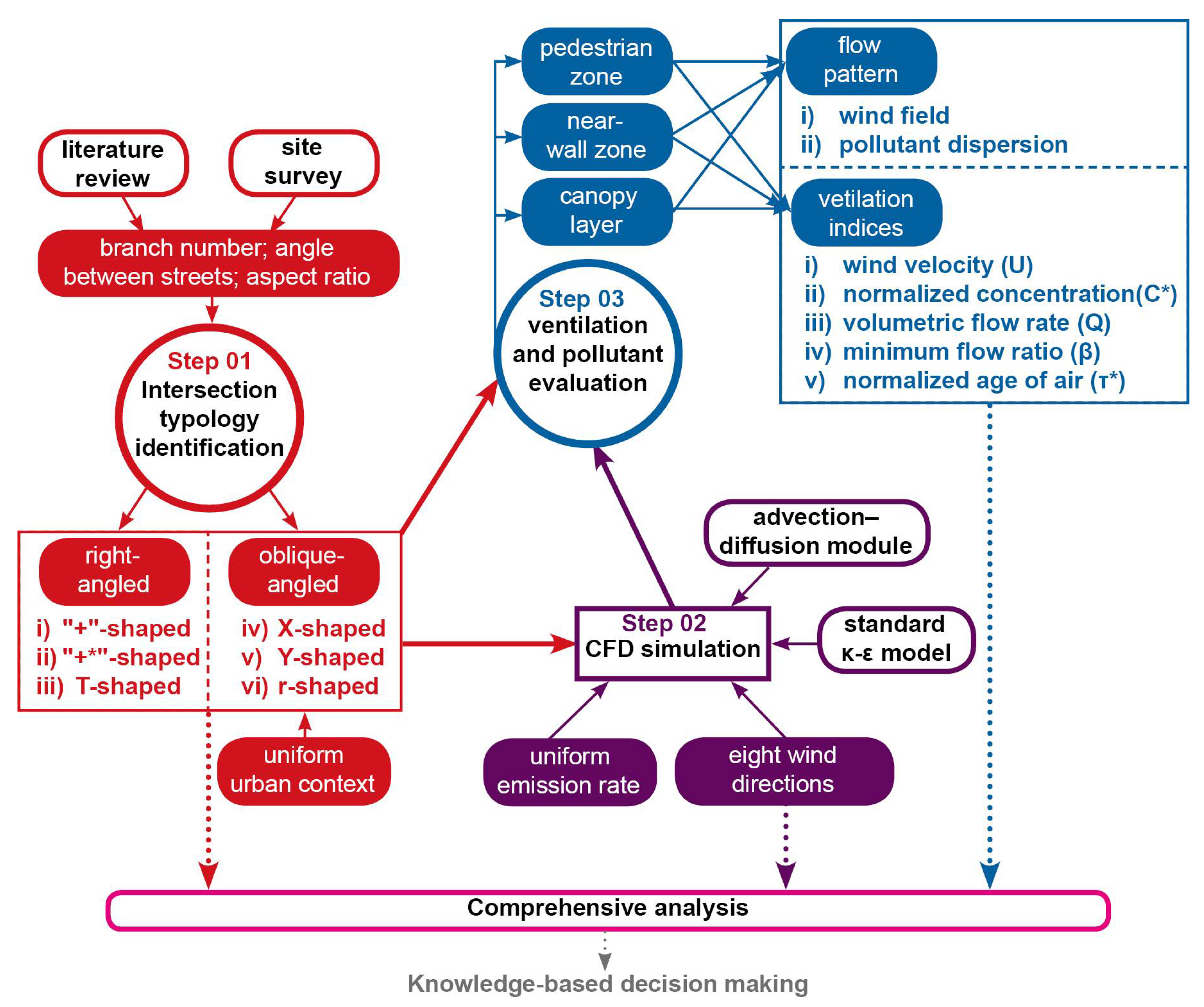


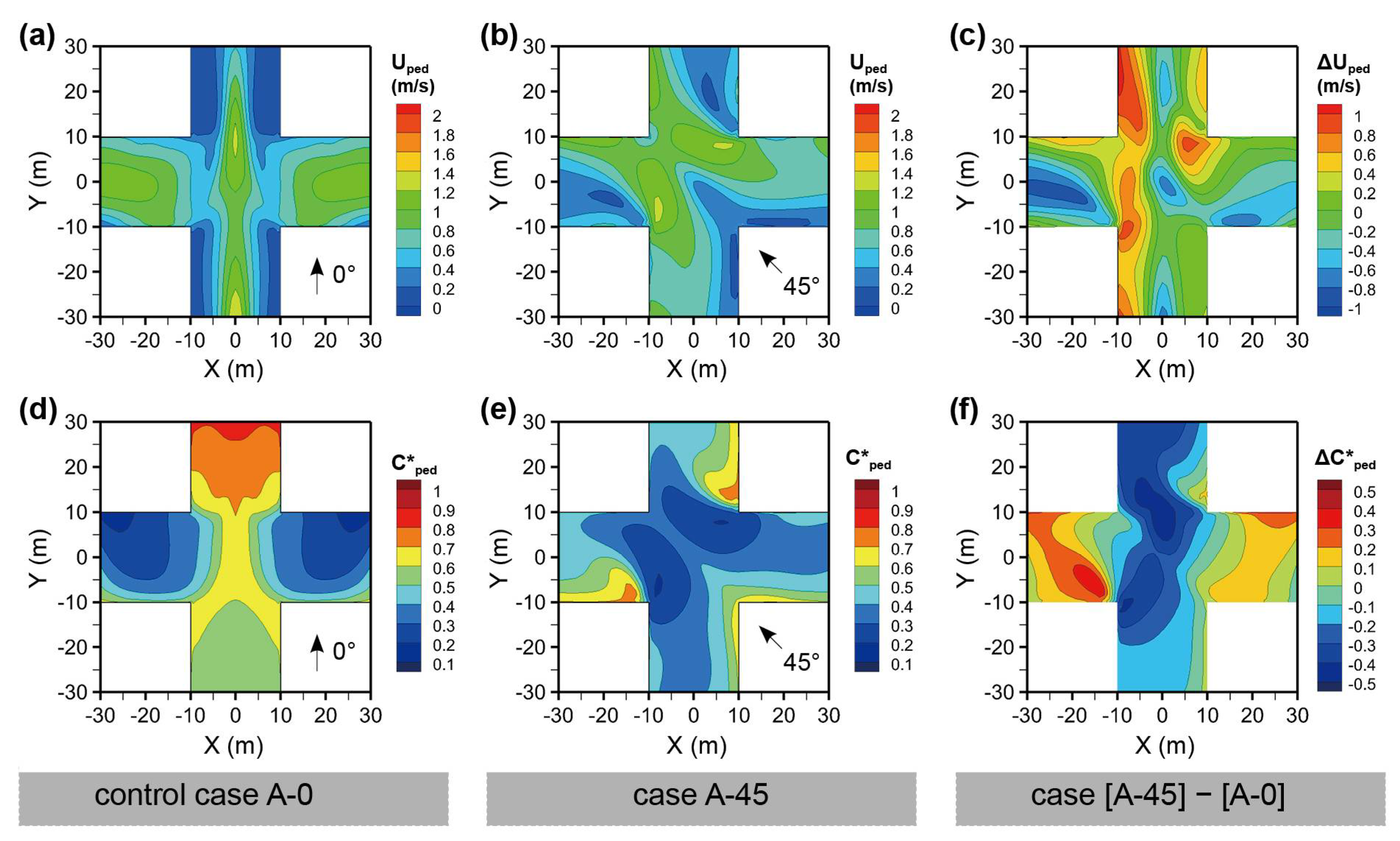
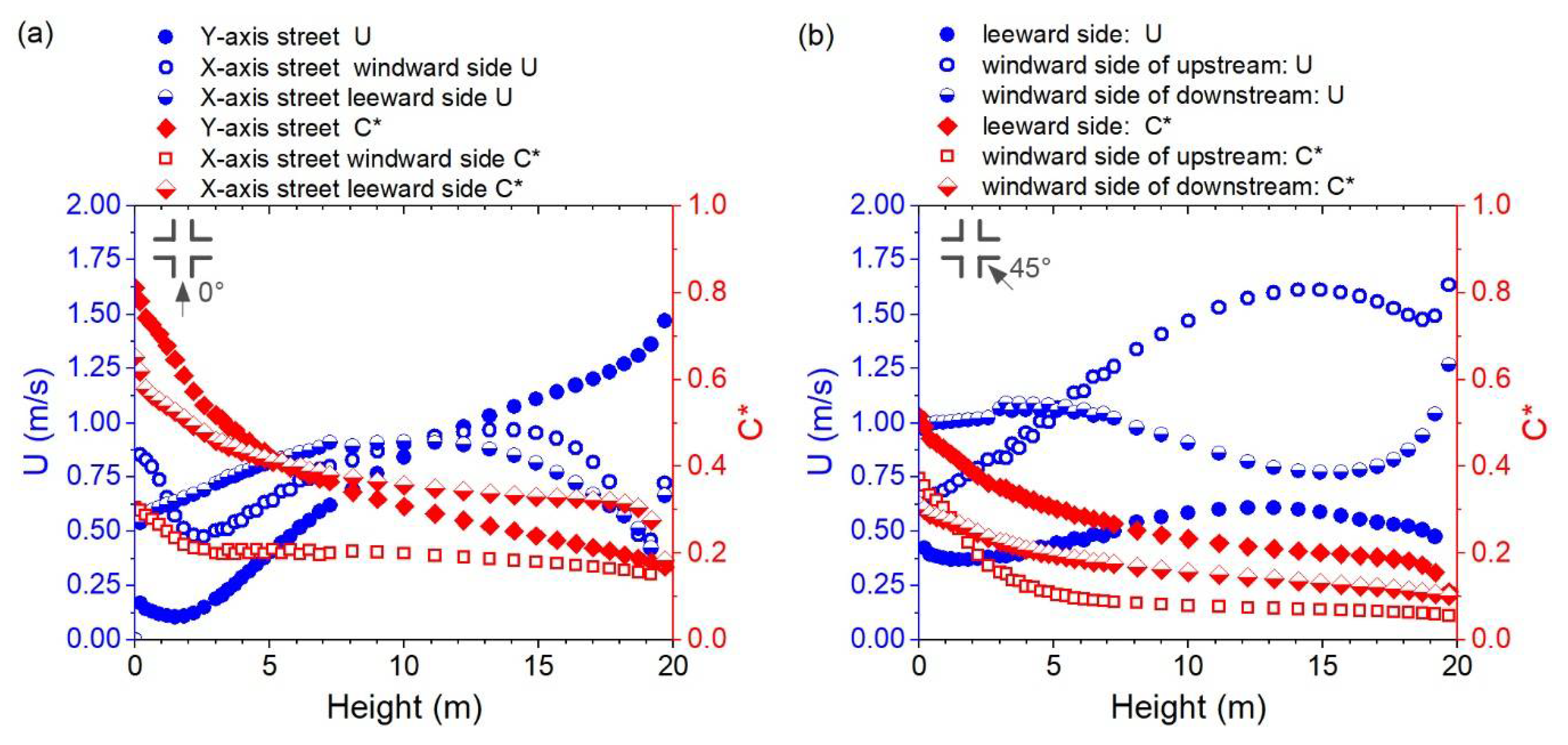
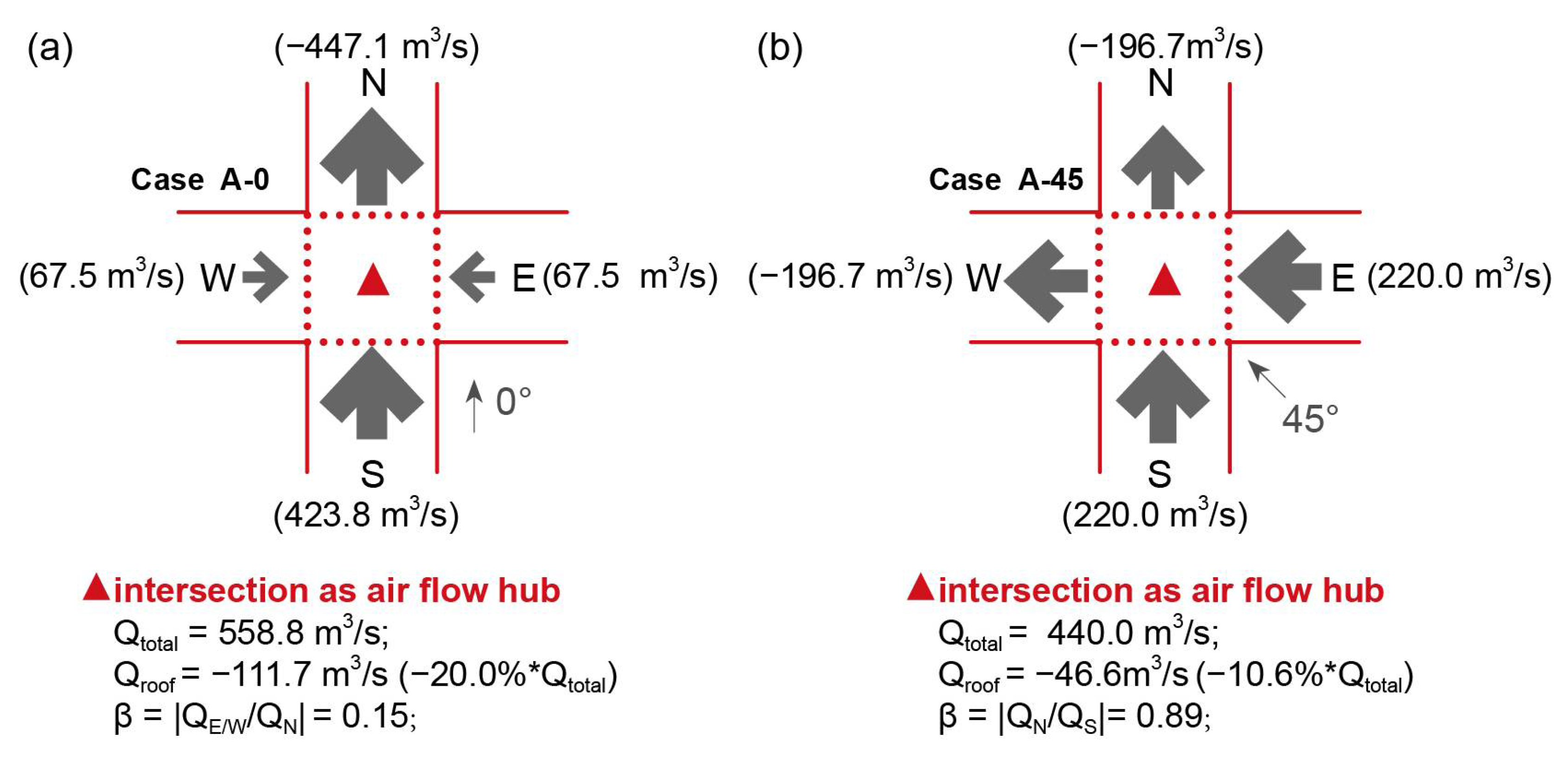
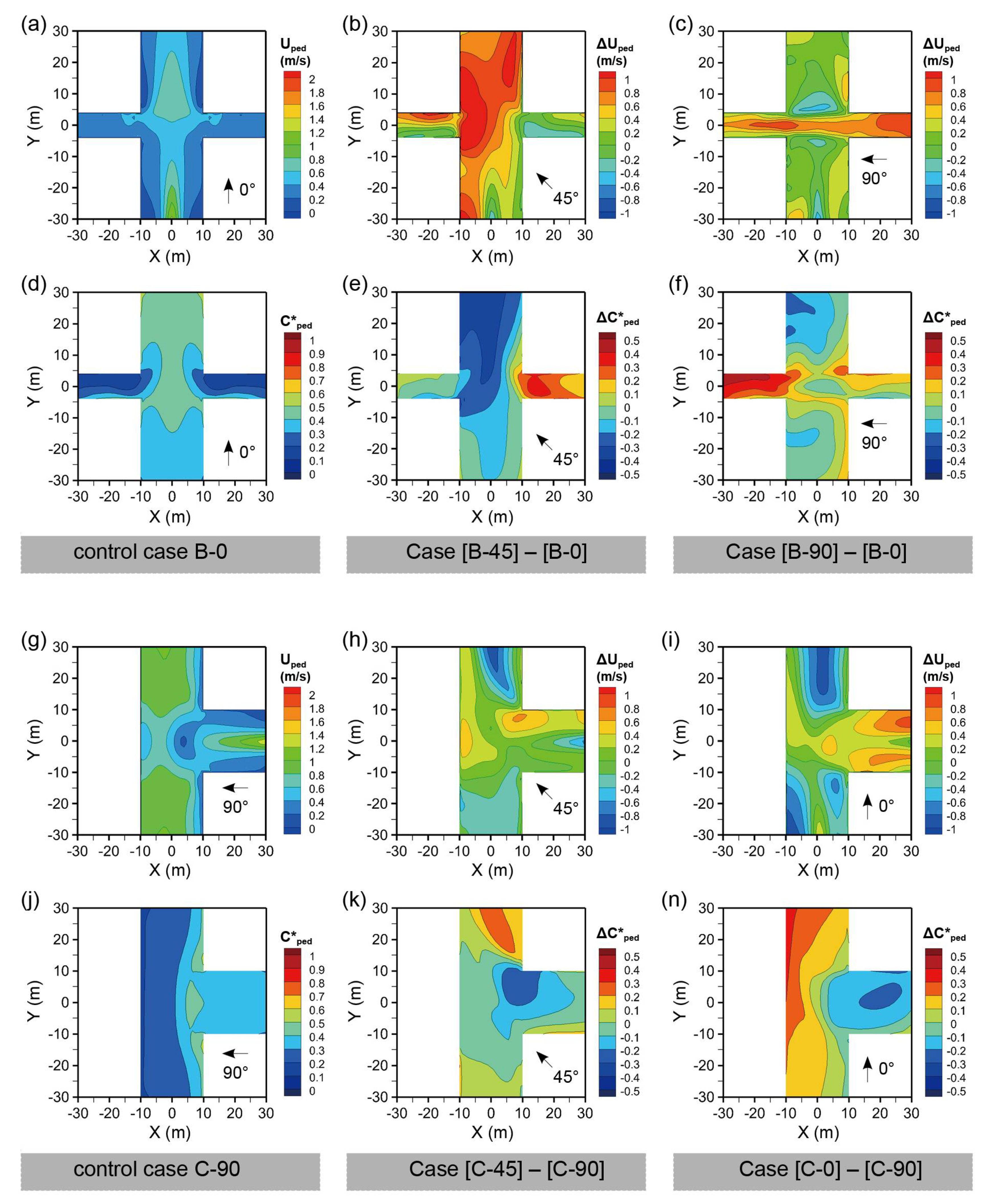
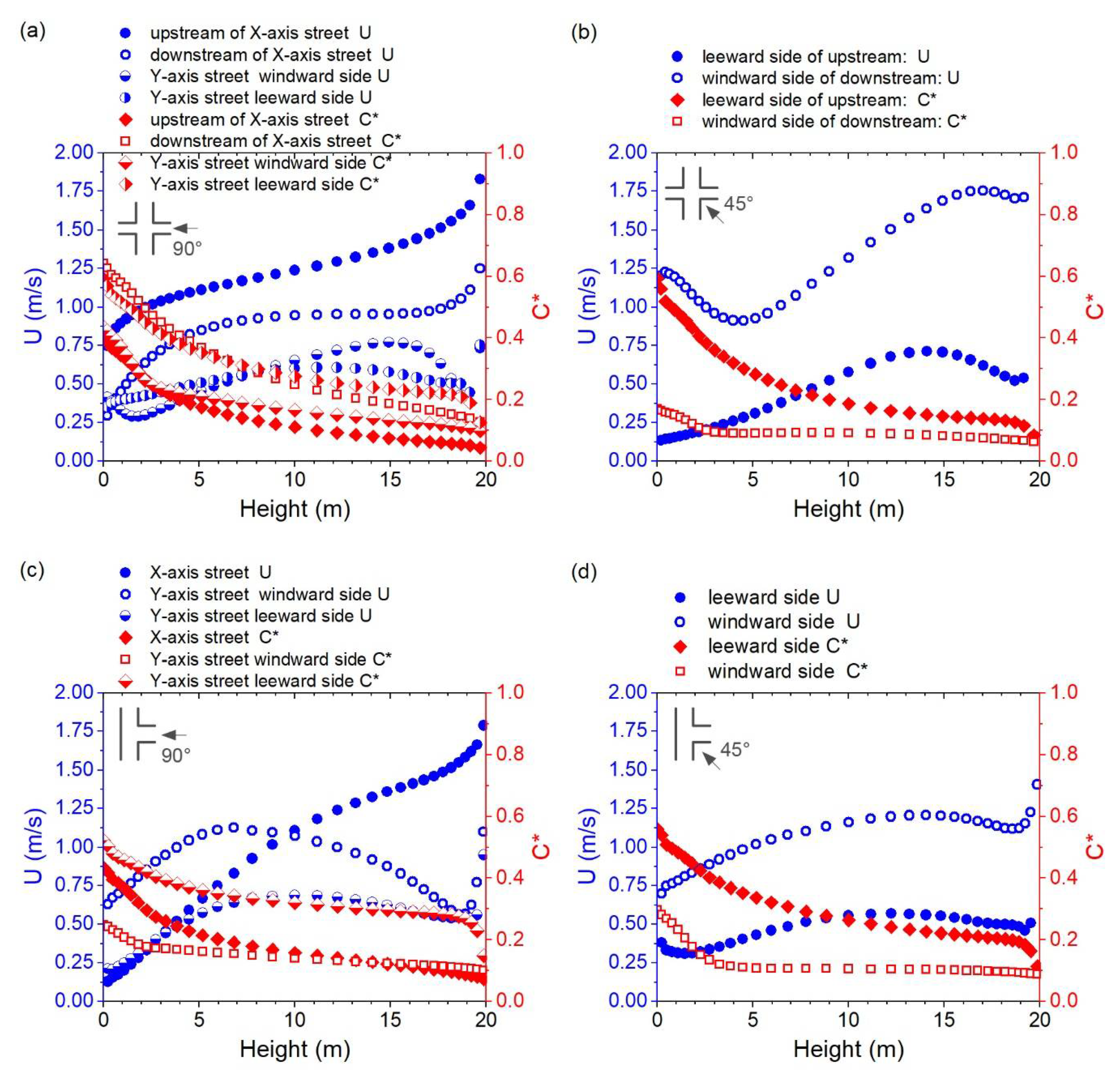
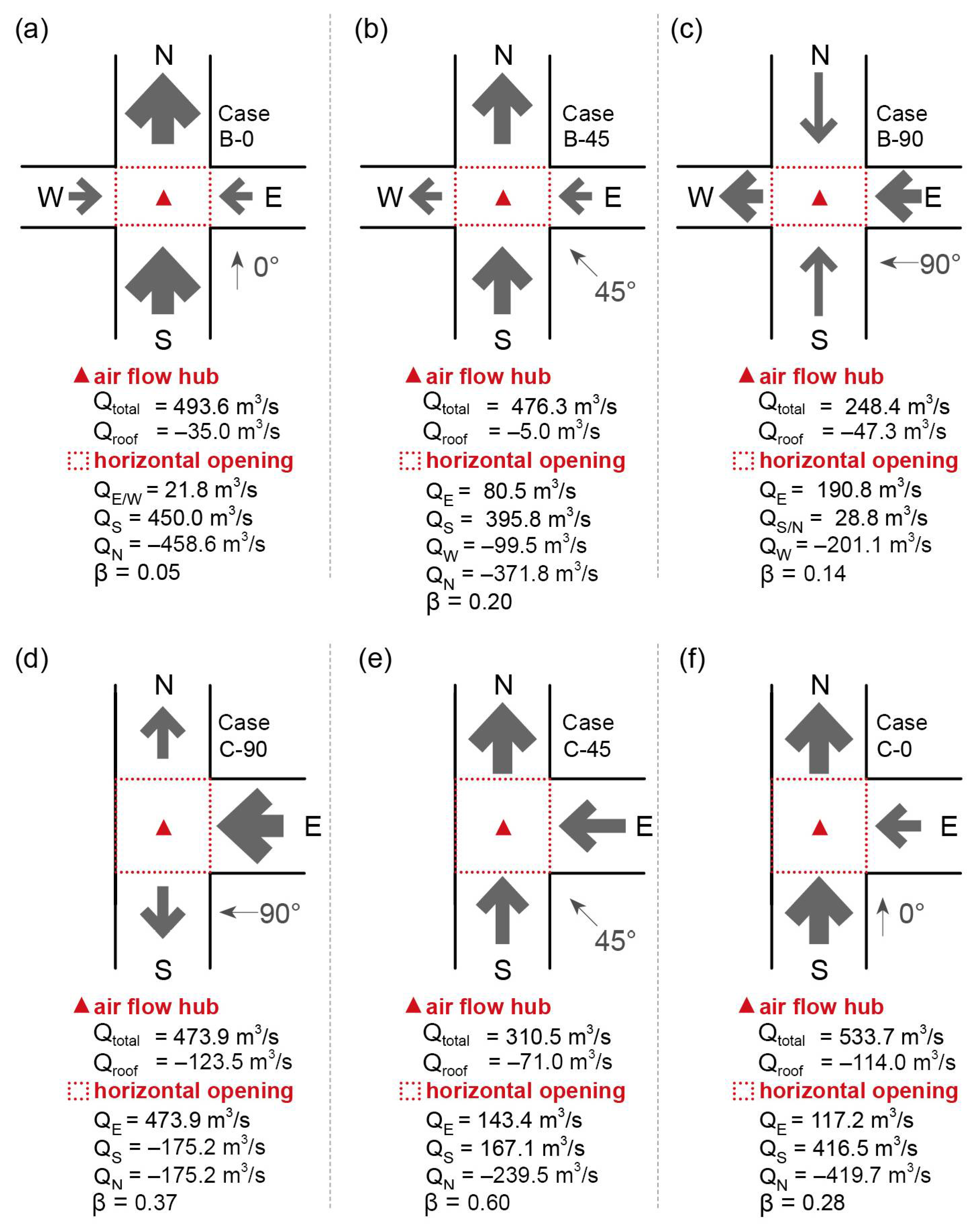
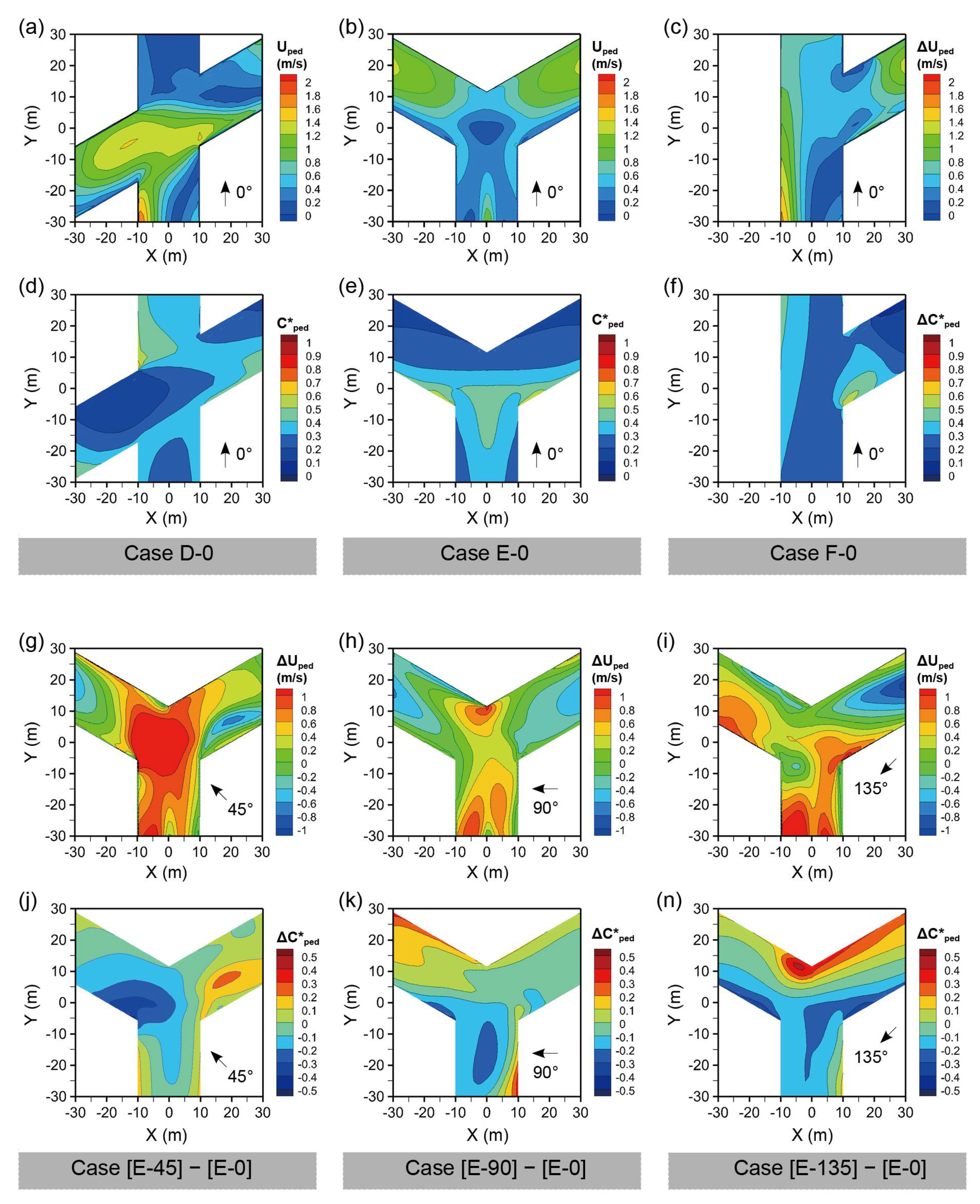
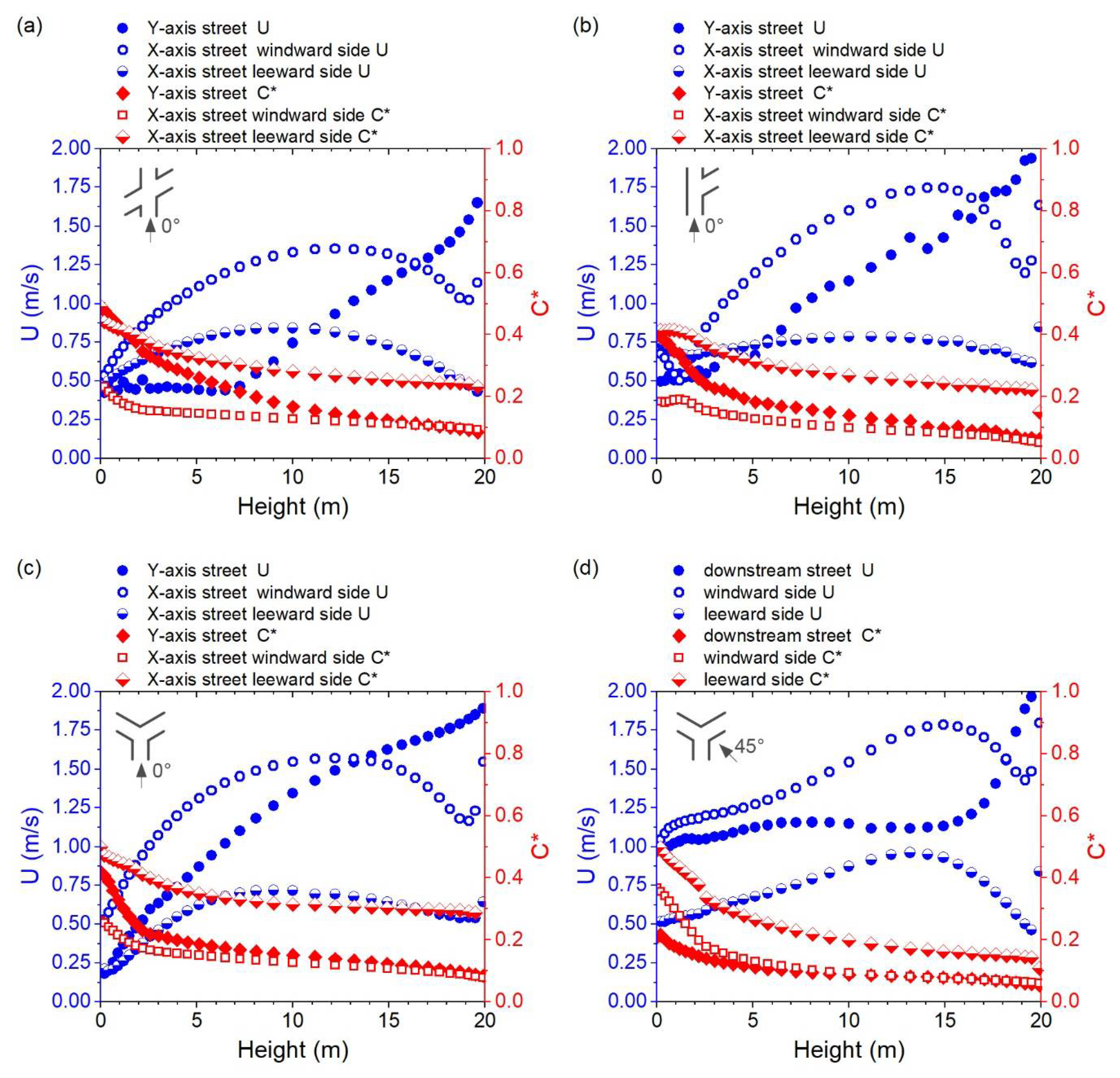

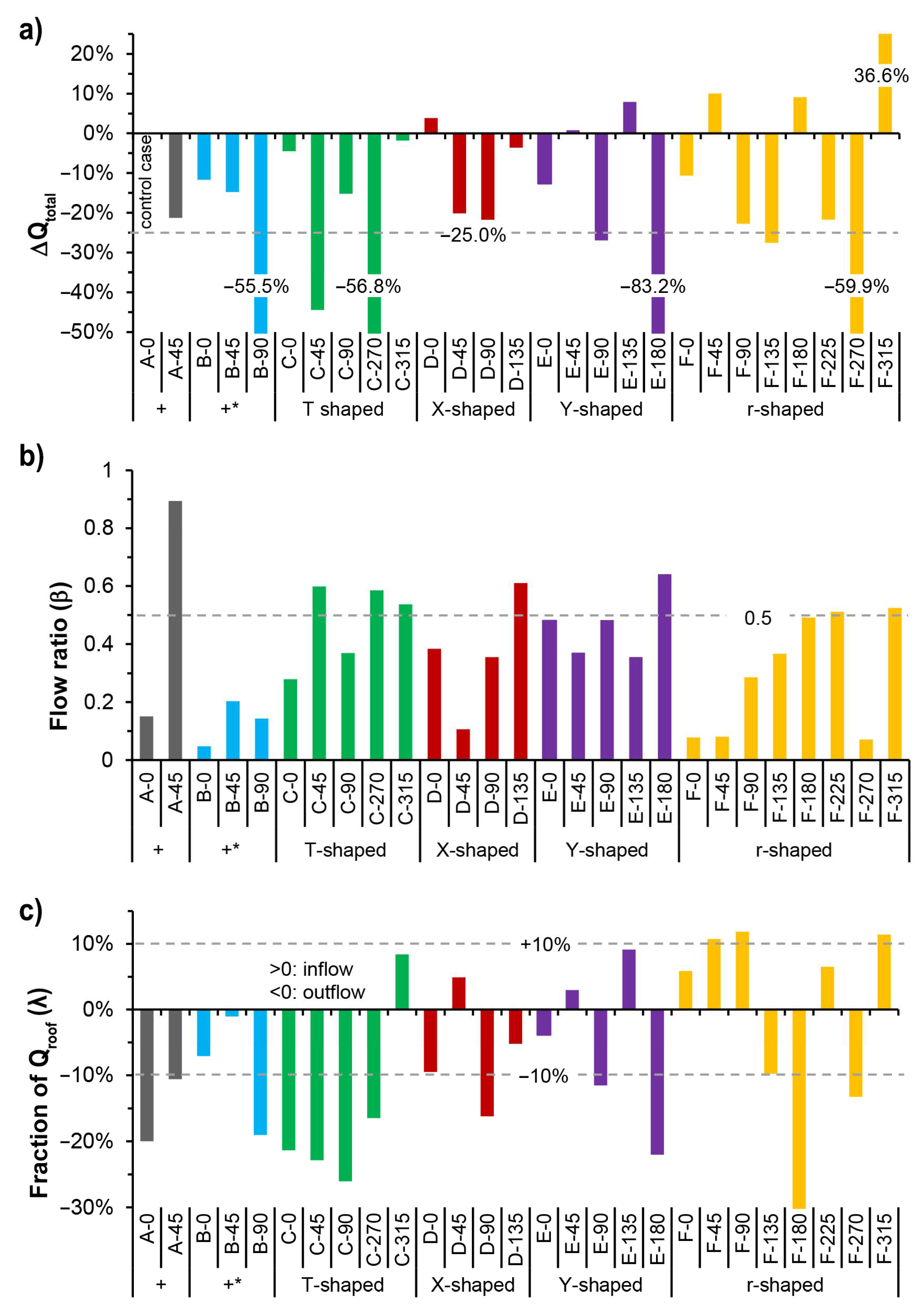
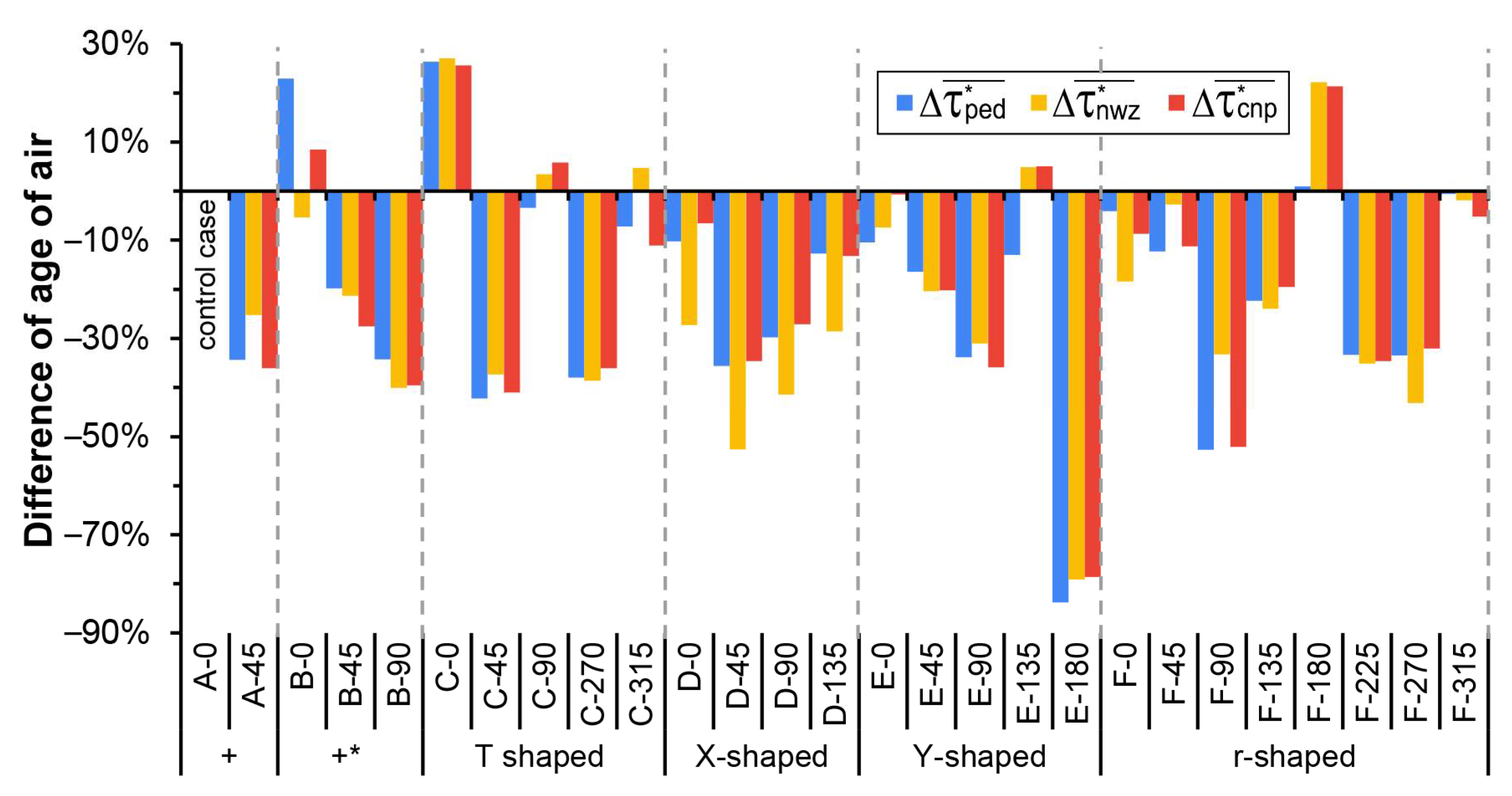
| Cases | ||||
|---|---|---|---|---|
| Case A (“+”-shaped) | A-0 | 0.37 | 0.24 | 0.22 |
| A-45 | 0.31 (−16.6%) | 0.22 (−5.1%) | 0.18 (−18.8%) | |
| Case B (“+*”-shaped) | B-0 | 0.42 | 0.20 | 0.22 |
| B-45 | 0.28 (−32.4%) | 0.18 (−13.8%) | 0.15 (−30.7%) | |
| B-90 | 0.44 (6.3%) | 0.26 (25.9%) | 0.25 (10.8%) | |
| Case C (T-shaped) | C-90 | 0.34 | 0.23 | 0.22 |
| C-0 | 0.39 (16.1%) | 0.25 (9.0%) | 0.24 (5.5%) | |
| C-45 | 0.31 (−8.7%) | 0.21 (−7.5%) | 0.19 (−14.8%) | |
| C-270 | 0.43 (26.1%) | 0.27 (16.4%) | 0.27 (18.6%) | |
| C-315 | 0.28 (−17.0%) | 0.20 (−12.6%) | 0.16 (−27.4%) | |
| Cases | ||||
|---|---|---|---|---|
| Case D (X-shaped) | D-0 | 0.34 | 0.21 | 0.21 |
| D-45 | 0.32 (−6.7%) | 0.17 (−15.3%) | 0.20 (−9.0%) | |
| D-90 | 0.35 (3.8%) | 0.22 (6.8%) | 0.22 (3.5%) | |
| D-135 | 0.36 (4.8%) | 0.22 (5.8%) | 0.21 (0.0%) | |
| Case E (Y-shaped) | E-0 | 0.34 | 0.23 | 0.23 |
| E-45 | 0.28 (−19.1%) | 0.17 (−25.5%) | 0.16 (−30.4%) | |
| E-90 | 0.30 (−11.7%) | 0.20 (−10.9%) | 0.18 (−22.9%) | |
| E-135 | 0.27 (−21.3%) | 0.21 (−8.3%) | 0.20 (−14.3%) | |
| E-180 | 0.32 (−6.0%) | 0.27 (17.2%) | 0.26 (11.8%) | |
| Case F (r-shaped) | F-0 | 0.33 | 0.18 | 0.19 |
| F-45 | 0.25 (−25.7%) | 0.17 (−3.0%) | 0.15 (−21.0%) | |
| F-90 | 0.19 (−42.9%) | 0.17 (−5.3%) | 0.12 (−39.3%) | |
| F-135 | 0.33 (−0.1%) | 0.21 (15.0%) | 0.21 (8.6%) | |
| F-180 | 0.29 (−13.8%) | 0.22 (22.7%) | 0.21 (8.8%) | |
| F-225 | 0.26 (−20.7%) | 0.16 (−9.2%) | 0.16 (−18.3%) | |
| F-270 | 0.51 (54.7%) | 0.28 (55.4%) | 0.32 (65.9%) | |
| F-315 | 0.23 (−32.2%) | 0.14 (−21.3%) | 0.13 (−32.1%) | |
Publisher’s Note: MDPI stays neutral with regard to jurisdictional claims in published maps and institutional affiliations. |
© 2021 by the authors. Licensee MDPI, Basel, Switzerland. This article is an open access article distributed under the terms and conditions of the Creative Commons Attribution (CC BY) license (https://creativecommons.org/licenses/by/4.0/).
Share and Cite
Zhang, M.; Gao, Z.; Guo, X.; Shen, J. Ventilation and Pollutant Concentration for the Pedestrian Zone, the Near-Wall Zone, and the Canopy Layer at Urban Intersections. Int. J. Environ. Res. Public Health 2021, 18, 11080. https://doi.org/10.3390/ijerph182111080
Zhang M, Gao Z, Guo X, Shen J. Ventilation and Pollutant Concentration for the Pedestrian Zone, the Near-Wall Zone, and the Canopy Layer at Urban Intersections. International Journal of Environmental Research and Public Health. 2021; 18(21):11080. https://doi.org/10.3390/ijerph182111080
Chicago/Turabian StyleZhang, Mingjie, Zhi Gao, Xin Guo, and Jialei Shen. 2021. "Ventilation and Pollutant Concentration for the Pedestrian Zone, the Near-Wall Zone, and the Canopy Layer at Urban Intersections" International Journal of Environmental Research and Public Health 18, no. 21: 11080. https://doi.org/10.3390/ijerph182111080
APA StyleZhang, M., Gao, Z., Guo, X., & Shen, J. (2021). Ventilation and Pollutant Concentration for the Pedestrian Zone, the Near-Wall Zone, and the Canopy Layer at Urban Intersections. International Journal of Environmental Research and Public Health, 18(21), 11080. https://doi.org/10.3390/ijerph182111080







